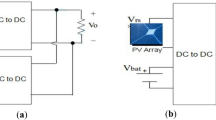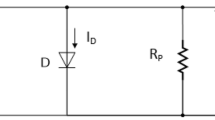Abstract
This paper presents a design of modular multilevel inverter (MMI) using multicarrier PWM (MCPWM) techniques to improve the power quality. The proposed research work explores with the solar fed single phase eleven level inverter and modeling of MCPWM. MMI is designed and developed by employing the modulation techniques for generating the higher output voltage amplitude with several output levels. MCPWM is used for generating switching pulses for the proposed 11-level inverter. The level shifting MCPWM technique is used in this work to investigate a multilevel inverter with equal DC sources. The modeling of modulation approaches is set up in MATLAB/Simulink, and the same findings are tested experimentally to establish the schemes' practicality.















Similar content being viewed by others
References
Ajami A, Oskuee MRJ, Mokhberdoran A, Van den Bossche A (2013) Developed cascaded multilevel inverter topology to minimise the number of circuit devices and voltage stresses of switches. IET Power Electron 7(2):459–466
Ali JSM, Krishnasamy V (2018) Compact switched capacitor multilevel inverter (CSCMLI) with self-voltage balancing and boosting ability. IEEE Trans Power Electron 34(5):4009–4013
Babaei E, Laali S, Alilu S (2014) Cascaded multilevel inverter with series connection of novel H-bridge basic units. IEEE Trans Ind Electron 61(12):6664–6671
Babaeia E, Kangarlua MF, Sabahia M, Pahlavanib MRA (2013) Cascaded multilevel inverter using sub-multilevel cells. Electr Power Syst Res 96:101–110
Chincholkar SH, Jiang W, Chan CY (2019) A normalized output error-based sliding-mode controller for the DC–DC cascade boost converter. IEEE Trans Circuits Syst II Express Briefs 67(1):92–96
Colak I, Kabalci E, Bayindir R (2011) Review of multilevel voltage source inverter topologies and control schemes. Energy Convers Manag 52(2):1114–1128
Gautam SP, Kumar L, Gupta S (2015) Hybrid topology of symmetrical multilevel inverter using less number of devices. IET Power Electron 8(11):2125–2135
Gautam SP, Sahu LK, Gupta S (2016) Reduction in number of devices for symmetrical and asymmetrical multilevel inverters. IET Power Electron 9(4):698–709
Gnanavel C, Albert Alexander S (2018) Experimental validation of an eleven level symmetrical inverter using genetic algorithm and queen bee assisted genetic algorithm for solar photovoltaic applications. J Circ Syst Comput 27(13):1850212
Gnanavel C, Vanchinathan K (2012) Novel voltage stability analysis of a grid connected-photovoltic system. J Global Res Comput Sci 3(7):2012
Gnanavel C, Immanuel TB, Muthukumar P, Kanthan PSL (2018) Investigation on four quadrant operation of BLDC MOTOR using spartan-6 FPGA. In: International conference on soft computing systems. Springer, Singapore, pp 752–763
Gnanavel C, Khanna PS, Rajavelan M, Vanchinathan K, Gokul C (2020) Real time monitoring and controlling of boiler drum parameters using internet of things (IoT). Test Eng Manag 82:2195–2198
Gokul C, Khanna S, Gnanavel C, Vanchinathan K, Patrica L (2020) Experimental investigation of hybrid battery/super capacitor energy storage system for electric vehicles. Int J Adv Sci Technol 29(4):1013–1021
Gupta KK, Jain S (2013) A novel multilevel inverter based on switched DC sources. IEEE Trans Ind Electron 61(7):3269–3278
Natarajan P, Palanisamy K (2015) Investigation of single phase reduced switch count asymmetric multilevel inverter using advanced pulse width modulation technique. Int J Renew Energy Res (IJRER) 5(3):879–890
Palanivel P, Dash SS (2011) Analysis of THD and output voltage performance for cascaded multilevel inverter using carrier pulse width modulation techniques. IET Power Electron 4(8):951–958
Prabaharan N, Fathima AH, Palanisamy K (2015, Oct) New hybrid multilevel inverter topology with reduced switch count using carrier based pulse width modulation technique. In: 2015 IEEE conference on energy conversion (CENCON), pp 176–180
Prabaharan N, Palanisamy K (2016a) Analysis and integration of multilevel inverter configuration with boost converters in a photovoltaic system. Energy Convers Manag 128:327–342
Prabaharan N, Palanisamy K (2016b) Comparative analysis of symmetric and asymmetric reduced switch MLI topologies using unipolar pulse width modulation strategies. IET Power Electron 9(15):2808–2823
Saeedian M, Adabi ME, Hosseini SM, Adabi J, Pouresmaeil E (2018) A novel step-up single source multilevel inverter: topology, operating principle, and modulation. IEEE Trans Power Electron 34(4):3269–3282
Sahoo SK, Bhattacharya T (2017) Phase-shifted carrier-based synchronized sinusoidal PWM techniques for a cascaded H-bridge multilevel inverter. IEEE Trans Power Electron 33(1):513–524
Stonier AA, Chinnaraj G, Kannan R, Mani G (2020) Investigation and validation of an eleven level symmetric modular multilevel inverter using grey wolf optimization and differential evolution control algorithm for solar PV applications. Circuit World 47(1):117–127
Vanchinathan K, Valluvan KR (2015) Improvement of time response for sensorless control of BLDC motor drive using ant colony optimization technique. Int J Appl Eng Res 10(55):3519–3524
Wu D, Jiang N, Du W, Tang K, Cao X (2018) Particle swarm optimization with moving particles on scale-free networks. IEEE Trans Network Sci Eng 7(1):497–506
Funding
This study did not receive any funding in any form.
Author information
Authors and Affiliations
Corresponding author
Ethics declarations
Conflict of interest
The authors of this paper do not have any conflict of interest.
Informed consent
All individuals included in the study gave their informed consent before taking part.
Research involving human participants and/or animals
The authors do not discuss the individuals or animals who took part in their research in any of the chapters.
Additional information
Publisher's Note
Springer Nature remains neutral with regard to jurisdictional claims in published maps and institutional affiliations.
Rights and permissions
Springer Nature or its licensor (e.g. a society or other partner) holds exclusive rights to this article under a publishing agreement with the author(s) or other rightsholder(s); author self-archiving of the accepted manuscript version of this article is solely governed by the terms of such publishing agreement and applicable law.
About this article
Cite this article
Chinnaraj, G., Kumarasamy, V., Paramasivan, M. et al. Mathematical formulation of multicarrier PWM techniques and design an eleven-level modular multilevel inverter to improve power quality. Int J Syst Assur Eng Manag 14, 1218–1227 (2023). https://doi.org/10.1007/s13198-023-01926-z
Received:
Revised:
Accepted:
Published:
Issue Date:
DOI: https://doi.org/10.1007/s13198-023-01926-z




